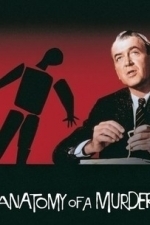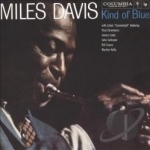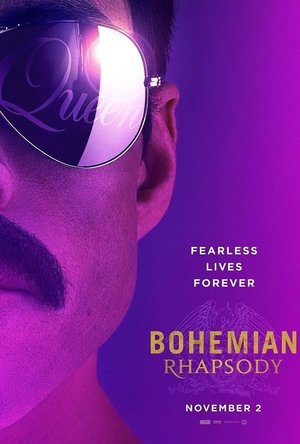Search
BankofMarquis (1832 KP) rated Anatomy of a Murder (1959) in Movies
Nov 30, 2018
One of the Best Courtroom Dramas of all Time
I have to admit, that (at times) the fun part of going to "SECRET MOVIE NIGHT" is the anticipation of not knowing what the film is. Sometimes the film is "good, not great" (like THE BLUES BROTHERS, BODY HEAT and A FACE IN THE CROWD) and other times it is a CLASSIC (Like CITIZEN KANE, THE APARTMENT and NETWORK). I am happy to report that this month's installment IS a classic, our old pal Jimmy Stewart in 1959's ANATOMY OF MURDER.
Directed by the great Otto Preminger, AOM is often referred to as the finest courtroom drama ever filmed. While I need to give that some thought, I will say AOM is right up there as one of the finest examples of a courtroom drama.
Starring Jimmy Stewart as "country lawyer" Paul Biegler, who is brought in to defend Army Lieutenant Manion (Ben Gazzara). Manion is accused of murdering a man that raped his wife (Lee Remick). The central mystery isn't "did Manion kill the man" (he did), it is more of "did he kill his wife's rapist or lover" and "will Biegler get away with the temporary insanity plea".
This is the kind of plot that we've all seen a dozen times on standard TV shows, but back in 1959, this type of film - and trial - was quite new and fresh and this film was "scandalous" in it's use of frank language. Remember, this is 1959 in Eisenhower "Happy Days" Americana, so hearing words like "bitch, panties, penetration, slut, sperm, bitch and slut" was quite shocking and led to many protests of the film.
Those who were turned off by the language and frankhandling of the subject matter lost out on an intriguing, well-acted, well-written and well-directed courtroom drama, where the verdict is up in the air right up until the foreman of the jury says "We, the jury, find the defendant..."
Jimmy Stewart is perfectly cast in the lead role of Defense Attorney, Biegler. Stewart brings an instant likableness and every man integrity quality to the role. His Attorney is down-to-earth but whip-smart, able to crack a joke to lighten the mood or explode in rage at an affront at a moment's notice. He goes toe-to-toe with Prosecuting Attorney Claude Dancer (a VERY young George C. Scott). Dancer is everything that Biegler is not, crisp, well-polished and arrogant. While it would have been very easy to paint these two characters as good (Stewart) and bad (Scott), Director Preminger and screenwriter Wendell Mayes shy away from this and show these two as fierce competitors playing a very serious game of chess - and this works very well, indeed. Both Stewart and Scott were nominated for Oscars for their work as Best Actor and Supporting Actor respectively.
The Supporting cast is superb, featuring such 1950's/early 1960's stalwarts as Arthur O'Connell (also Oscar nominated as Stewarts's alcoholic law mentor), the always good Eve Arden, Orson Bean and Katherine Grant. It also features three character actors in small roles (witnesses in the trial) who you would recognize from other things - Murray Hamilton (the Mayor in Jaws), Howard McNear (Floyd the Barber from Mayberry) and Joseph Kearns (Mr. Wilson in Dennis the Menace).
Special notice needs to be made for Lee Remick as the sultry and flirtatious woman at the core of the film. Remick is superb in this role, and that is fortunate, for if she wasn't believable in the "would she or won't she" role that she is asked to play, then the film could have easily fallen apart. But the real bright spot in this film is the scene stealing Joseph N. Welch as the Judge in the case. His performance as the judge is the perfect "third leg" to the Stewart/Scott stool, balancing charm, folksiness and strength in even portions (depending on what is needed to balance the other two).
Otto Preminger (LAURA, STALAG 17) is a Director who's name is beginning to fade into the dust of the past - and that's too bad, for he is a strong director who knows how to frame a scene and pace a film. Even though AOM is 2 hours and 40 minutes of talking, it never feels long or slow.
Two other aspects of this film need to be mentioned - the "jazz" score by the great Duke Ellington (which won a grammy) is perfectly suited to the themes and mood of this film and the opening title sequence (and movie poster) is reminiscent of an Alfred Hitchock film - and that is because they are done by frequent Hitchock contributor Saul Bass.
Nominated for 7 Oscars (it won zero, falling to the juggernaut that was BEN HUR that year), ANATOMY OF A MURDER is an intriguing courtroom drama that also opens the door to performers of the past. Well worth the time investment, should you run across it (it is frequently shown on TCM).
Letter Grade: A
9 (out of 10) stars and you can take that to the Bank(ofMarquis)
Directed by the great Otto Preminger, AOM is often referred to as the finest courtroom drama ever filmed. While I need to give that some thought, I will say AOM is right up there as one of the finest examples of a courtroom drama.
Starring Jimmy Stewart as "country lawyer" Paul Biegler, who is brought in to defend Army Lieutenant Manion (Ben Gazzara). Manion is accused of murdering a man that raped his wife (Lee Remick). The central mystery isn't "did Manion kill the man" (he did), it is more of "did he kill his wife's rapist or lover" and "will Biegler get away with the temporary insanity plea".
This is the kind of plot that we've all seen a dozen times on standard TV shows, but back in 1959, this type of film - and trial - was quite new and fresh and this film was "scandalous" in it's use of frank language. Remember, this is 1959 in Eisenhower "Happy Days" Americana, so hearing words like "bitch, panties, penetration, slut, sperm, bitch and slut" was quite shocking and led to many protests of the film.
Those who were turned off by the language and frankhandling of the subject matter lost out on an intriguing, well-acted, well-written and well-directed courtroom drama, where the verdict is up in the air right up until the foreman of the jury says "We, the jury, find the defendant..."
Jimmy Stewart is perfectly cast in the lead role of Defense Attorney, Biegler. Stewart brings an instant likableness and every man integrity quality to the role. His Attorney is down-to-earth but whip-smart, able to crack a joke to lighten the mood or explode in rage at an affront at a moment's notice. He goes toe-to-toe with Prosecuting Attorney Claude Dancer (a VERY young George C. Scott). Dancer is everything that Biegler is not, crisp, well-polished and arrogant. While it would have been very easy to paint these two characters as good (Stewart) and bad (Scott), Director Preminger and screenwriter Wendell Mayes shy away from this and show these two as fierce competitors playing a very serious game of chess - and this works very well, indeed. Both Stewart and Scott were nominated for Oscars for their work as Best Actor and Supporting Actor respectively.
The Supporting cast is superb, featuring such 1950's/early 1960's stalwarts as Arthur O'Connell (also Oscar nominated as Stewarts's alcoholic law mentor), the always good Eve Arden, Orson Bean and Katherine Grant. It also features three character actors in small roles (witnesses in the trial) who you would recognize from other things - Murray Hamilton (the Mayor in Jaws), Howard McNear (Floyd the Barber from Mayberry) and Joseph Kearns (Mr. Wilson in Dennis the Menace).
Special notice needs to be made for Lee Remick as the sultry and flirtatious woman at the core of the film. Remick is superb in this role, and that is fortunate, for if she wasn't believable in the "would she or won't she" role that she is asked to play, then the film could have easily fallen apart. But the real bright spot in this film is the scene stealing Joseph N. Welch as the Judge in the case. His performance as the judge is the perfect "third leg" to the Stewart/Scott stool, balancing charm, folksiness and strength in even portions (depending on what is needed to balance the other two).
Otto Preminger (LAURA, STALAG 17) is a Director who's name is beginning to fade into the dust of the past - and that's too bad, for he is a strong director who knows how to frame a scene and pace a film. Even though AOM is 2 hours and 40 minutes of talking, it never feels long or slow.
Two other aspects of this film need to be mentioned - the "jazz" score by the great Duke Ellington (which won a grammy) is perfectly suited to the themes and mood of this film and the opening title sequence (and movie poster) is reminiscent of an Alfred Hitchock film - and that is because they are done by frequent Hitchock contributor Saul Bass.
Nominated for 7 Oscars (it won zero, falling to the juggernaut that was BEN HUR that year), ANATOMY OF A MURDER is an intriguing courtroom drama that also opens the door to performers of the past. Well worth the time investment, should you run across it (it is frequently shown on TCM).
Letter Grade: A
9 (out of 10) stars and you can take that to the Bank(ofMarquis)

Typhoons by Royal Blood
Album
After two UK #1 albums, 2 million album sales and an array of international acclaim, you might’ve...
Mick Hucknall recommended Kind of Blue by Miles Davis in Music (curated)
Bob Mann (459 KP) rated Bohemian Rhapsody (2018) in Movies
Sep 28, 2021
“Fame and fortune and everything that goes with it”.
Sometimes a trailer generates a bit of a buzz of excitement with a cinema audience and the first showings of the trailer for “Bohemian Rhapsody” was a case in point. But would the film live up to the potential?
The Plot
Farrokh Bulsara (Rami Malek), born in Zanzibar to Indian parents, is a shy boy with a dramatic singing voice. At a concert he meets Mary (Lucy Boynton) who becomes the “love of his life”. When a space for a lead singer becomes available in a college band, Farrokh leaps at the chance and onstage becomes an exuberant extrovert. The band, of course, changes its name to Queen and with Farrokh assuming the name of Freddie Mercury they are set for global success. But Freddie is a complex character, and the demands and temptations of global super-stardom take a terrible toll.
The Review
Wow! What a great film on so many different levels. As a biopic of Mercury and a history of one of the greatest ever rock bands, the film is highly entertaining. But I wasn’t prepared for how emotional I would find it. Mercury’s life is befitting of a Shakespearian tragedy: an estrangement from his ‘conservative’ father (Ace Bhatti); a public extravert, but privately an insecure and needy bi-sexual, constantly searching for his perch in life; a meteoric rise and an equally spectacular and historic fall.
Do you remember where you were (if anywhere!) during the historic Live Aid concert at Wembley in July 1985? My eagle-minded wife had to remind me that we were travelling to Hampshire to house hunt because of my graduate job offer from IBM Hursley Park. My 3 month old daughter was rolling around, unstrapped, in a carry cot on the back seat: different times; different rules! Why this is relevant is that the film culminates in a recreation of the band’s spectacular 20 minute set for 1985’s Live Aid concert at Wembley. It’s a spectacular piece of cinema and one that – for me – puts the much hyped concert scenes from “A Star is Born” back in its box. Aside from a few niggles (the sound engineers in the booth were, if I’m not mistaken, all the size of Hagrid!) it’s a spectacular piece of CGI work.
It’s also worth remembering that whilst today’s massive stadium concerts from the likes of Adele and Coldplay are commonplace, back in the UK of 1985 most of the bands played in more traditional theatre venues: this really was an historic event on so many levels.
If I’m being critical, there are a few bits of the movie that are a tad tacky and twee. A whizz around the world of tour locations is composed of some pretty ropy animations that didn’t work for me. And a few of the ‘creations’ of classic songs – particularly “Another One Bites the Dust” – are a bit forced. Countering that though, the “Bohemian Rhapsody” is mesmerising.
The Turns
I’ll just put it right out there, Rami Malek is just sensational as Mercury! I first called out Malek as someone to watch in “Need For Speed“, but since then he’s gone on to major fame in the TV series “Mr Robot”. Here he is a force of nature on the screen and you literally can’t take your eyes off him. Every nuance of Mercury’s tortured soul is up there. I would love to see the performance recognized in the Awards season, with the showreel clip being a brilliant standoff in the rain with Paul Prenter (“Downton’s” Allen Leech).
The rest of the band – Ben Hardy as drummer Roger Taylor; Gwilym Lee as lead guitar Brian May; and Joseph Mazzello (yes, young Tim from “Jurassic Park”!) as bass guitarist John Deacon – all work well together, with Lee looking more like Brian May than Brian May!
Lucy Boynton, so great in “Sing Street“, gets a meaty dramatic role to sink her teeth into, and the ever-reliable Tom Hollander is great as the band’s legal rep/manager Jim “Miami” Beech: his ‘knowing looks’ near the end of the film are brilliantly done.
The surprise piece of casting though was the very welcome return of Mike Myers as the exec Ray Foster: only seen spasmodically on screen since 2009’s “Inglorious Basterds”. It’s a role that reminded me of Tom Cruise‘s turn in “Tropic Thunder”! But it’s well done. After making “Bohemian Rhapsody” famous again in “Wayne’s World”, how could he have refused? I say “Welcome back Mr Myers”: you’ve been missed.
And a final shout out to Paul Jones, my son-in-law’s brother, who gets a full screen appearance in the crowd, arms outstretched, during the “Fat Bottomed Girls” set! (I must admit, I missed it, so will have to go and see it again!)
Final Thoughts
This is a film that grabs you and propels you through the story at a fast lick. It’s a surprisingly moving story, with a well-known and tragic finale. It’s not a perfect film, but it is up there wih the year’s best as a high-energy cinema experience.
The Plot
Farrokh Bulsara (Rami Malek), born in Zanzibar to Indian parents, is a shy boy with a dramatic singing voice. At a concert he meets Mary (Lucy Boynton) who becomes the “love of his life”. When a space for a lead singer becomes available in a college band, Farrokh leaps at the chance and onstage becomes an exuberant extrovert. The band, of course, changes its name to Queen and with Farrokh assuming the name of Freddie Mercury they are set for global success. But Freddie is a complex character, and the demands and temptations of global super-stardom take a terrible toll.
The Review
Wow! What a great film on so many different levels. As a biopic of Mercury and a history of one of the greatest ever rock bands, the film is highly entertaining. But I wasn’t prepared for how emotional I would find it. Mercury’s life is befitting of a Shakespearian tragedy: an estrangement from his ‘conservative’ father (Ace Bhatti); a public extravert, but privately an insecure and needy bi-sexual, constantly searching for his perch in life; a meteoric rise and an equally spectacular and historic fall.
Do you remember where you were (if anywhere!) during the historic Live Aid concert at Wembley in July 1985? My eagle-minded wife had to remind me that we were travelling to Hampshire to house hunt because of my graduate job offer from IBM Hursley Park. My 3 month old daughter was rolling around, unstrapped, in a carry cot on the back seat: different times; different rules! Why this is relevant is that the film culminates in a recreation of the band’s spectacular 20 minute set for 1985’s Live Aid concert at Wembley. It’s a spectacular piece of cinema and one that – for me – puts the much hyped concert scenes from “A Star is Born” back in its box. Aside from a few niggles (the sound engineers in the booth were, if I’m not mistaken, all the size of Hagrid!) it’s a spectacular piece of CGI work.
It’s also worth remembering that whilst today’s massive stadium concerts from the likes of Adele and Coldplay are commonplace, back in the UK of 1985 most of the bands played in more traditional theatre venues: this really was an historic event on so many levels.
If I’m being critical, there are a few bits of the movie that are a tad tacky and twee. A whizz around the world of tour locations is composed of some pretty ropy animations that didn’t work for me. And a few of the ‘creations’ of classic songs – particularly “Another One Bites the Dust” – are a bit forced. Countering that though, the “Bohemian Rhapsody” is mesmerising.
The Turns
I’ll just put it right out there, Rami Malek is just sensational as Mercury! I first called out Malek as someone to watch in “Need For Speed“, but since then he’s gone on to major fame in the TV series “Mr Robot”. Here he is a force of nature on the screen and you literally can’t take your eyes off him. Every nuance of Mercury’s tortured soul is up there. I would love to see the performance recognized in the Awards season, with the showreel clip being a brilliant standoff in the rain with Paul Prenter (“Downton’s” Allen Leech).
The rest of the band – Ben Hardy as drummer Roger Taylor; Gwilym Lee as lead guitar Brian May; and Joseph Mazzello (yes, young Tim from “Jurassic Park”!) as bass guitarist John Deacon – all work well together, with Lee looking more like Brian May than Brian May!
Lucy Boynton, so great in “Sing Street“, gets a meaty dramatic role to sink her teeth into, and the ever-reliable Tom Hollander is great as the band’s legal rep/manager Jim “Miami” Beech: his ‘knowing looks’ near the end of the film are brilliantly done.
The surprise piece of casting though was the very welcome return of Mike Myers as the exec Ray Foster: only seen spasmodically on screen since 2009’s “Inglorious Basterds”. It’s a role that reminded me of Tom Cruise‘s turn in “Tropic Thunder”! But it’s well done. After making “Bohemian Rhapsody” famous again in “Wayne’s World”, how could he have refused? I say “Welcome back Mr Myers”: you’ve been missed.
And a final shout out to Paul Jones, my son-in-law’s brother, who gets a full screen appearance in the crowd, arms outstretched, during the “Fat Bottomed Girls” set! (I must admit, I missed it, so will have to go and see it again!)
Final Thoughts
This is a film that grabs you and propels you through the story at a fast lick. It’s a surprisingly moving story, with a well-known and tragic finale. It’s not a perfect film, but it is up there wih the year’s best as a high-energy cinema experience.


